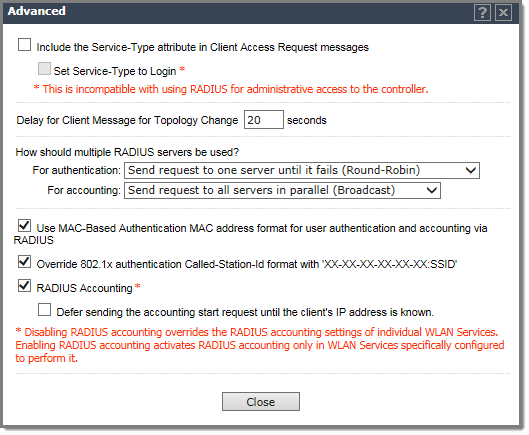
Advanced Radius Settings
| Field | Description |
|---|---|
| Include Service-Type attribute in Client Access Request messages | Select if the client RADIUS Access Request message includes the "Service-Type" attribute. If included, the attribute is set to "Framed" by default. |
| Set Service Type to Login | If selected, the RADIUS "Service-Type" attribute of the
client Access Request is set to "Login" (instead of "Framed"). Note: RADIUS-based controller administrative access also sets
the Service-Type attribute to "Login". Therefore, if you enable Service Type
Login here, RADIUS-based administrative access is not allowed (and vice
versa).
|
| Delay for Client Message for Topology Change | Defines a delay during client authentication when switching from one topology to another. This is relevant for Captive Portal authentication. The delay gives time for the client to be assigned an IP address for the new topology before browser redirection. Set the delay in seconds. |
| How should multiple RADIUS servers be used? | Select an authentication or accounting
option. The selection applies to all WLAN (Wireless Local Area Network) Services and to all sites on
the EWC.
|
| Use MAC-Based Authentication MAC address format for user authentication and accounting via RADIUS | Allows the administrator to override the default MAC
address colon-separated format (for example 00:11:22:33:44:55) with the Global
Authentication MAC Address format for the following attributes:
Note: This setting is enabled for new deployments.
You must manually enable this setting for upgraded deployments.
|
| Override 802.1x Authentication Call-Station-Id format with XX-XX-XX-XX-XX-XX:SSID | Allows the
administrator to override the Called-Station-Id attribute format for 802.1x
authentication with the format XX-XX-XX-XX-XX-XX:SSID. This setting is disabled
by default. When you select this option, the Called-Station-Id conforms to the format specified in RFC 3580 (IEEE 802.1X Remote Authentication Dial In User Service (RADIUS) Usage Guidelines). If the RADIUS server is processing this attribute, the RADIUS server has to support this format. Note: This setting overrides the setting Use MAC-Based Authentication MAC address
format for user authentication and accounting via
RADIUS.
|
| Radius Accounting | Enabling RADIUS accounting activates RADIUS accounting only in WLAN Services specifically configured to perform it. Disabling RADIUS accounting overrides the RADIUS accounting settings of individual WLAN Services. |
| Defer sending the accounting start request until the client's IP address is known | Specify Authentication Behavior of RADIUS servers on Server Failure. If selected, the client RADIUS Accounting Request "start" command is not sent to the RADIUS server until the client IP address is known. By default, this option is not selected and the "start" command is sent once the client is authenticated. |